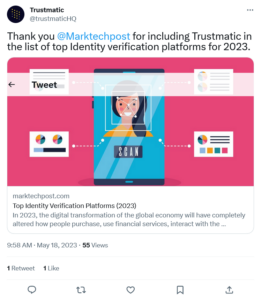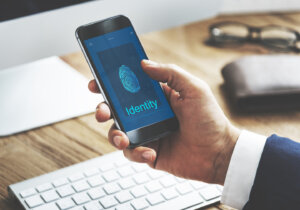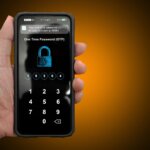Online ID checks, biometrics and more

• Online verification is evolving into new areas.
• Specialized apps and operators are helping delivering online verification.
• Bad actors are evolving their fraudulent techniques too.
Identity verification is critical to ensuring the security and longevity of companies across all sectors. As business moves online, verification methods must follow suit to prevent fraud and meet compliance regulations. Not only is it important that a customer can be identified correctly, but you can manage front-end risk to your company by verifying vendor identities too.
In the online landscape, risks are mounting. When physical documentation was the main way of verifying identity, there were fewer ways for criminals to intercede. Now, every technological advance brings new threats.
More risk avenues mean more verification methods are needed. Online, there’s more chance that a document will be fraudulent, so organizations are expected to take extra steps to verify customer and client identities.
It’s unlikely, however, that a company could carry out verification processes without a little help. There’s a huge market for identity verification platforms out there that use additional personal information beyond a username and password to verify the identity of an individual.
This additional information comes in various forms, including date of birth, government-issued IDs, voice recognition, biometrics, and even facial recognition.
Knowledge-based authentication is a common way to prevent fraudulent logins. After inputting their password, a customer is asked a security question that should have an easy to remember, hard to guess answer. The method is increasingly outdated, though, what with our pathological need to post everything – first pets, mother’s maiden name – on social media.
It’s important that when users sign up to a service, the account they use isn’t going to be spam. To check this, two-factor authentication should be used, proving that a user has access to the inbox of whatever contact method they provide on sign-up.
To enhance and ease this, Okta provides cloud software that helps companies manage and secure user authentication into applications, and helps developers build identity controls into applications, web services and devices.
Identity verification also protects a business by verifying new employees. This tends to be about checking documents, which is something that technology makes faster and easier, and reduces internal instances of identity theft, fraudulent transactions, and potential unauthorized access to an organization’s information.
Online verification methods
Primarily, identifying an individual determines whether a government-issues ID relates to the user. Often, to make such identification possible, a customer or employee must provide a photo or video of themselves holding a form of ID.
Although human verification is an option, international companies might waste hours dealing with regional documentation. Trustmatic automates trust between businesses and their customers. Its onboarding process has a first-time completion rate of 98% and the platform supports a variety of identity documents from over 248 countries and territories, along with 138 languages.

More and more companies are helping provide online authentication and verification.
Ondato does this type of live document verification. It integrates via a SaaS business model and offers modules on biometrics, e-signature and compliance management tools. Similarly, Token of Trust uses multiple ID verification types. The company offers government ID verification, electronic ID verification, document scanning, biometrics and age address or social verification.
Biometrics once seemed reserved for hi-tech spy movies, but now almost every smartphone user has their identity checked with biometrics every time they unlock their phone. Another buzzword that feels like it was only recently coined is “digital footprint.” As social media fearmongering has given way to AI worries, the focus on what information your digital footprint holds has diminished.

Ever unlock a phone with a fingerprint? Welcome to biometric verification.
However, for security checks, digital footprint analysis looks at the unique data that every individual accrues online. Relevant information includes IP fraud scoring, email and phone analysis, reverse social and digital platform lookup, PEP, blacklists, sanctions lists and crime watchlists. All of these things create a user profile.

Your digital footprint can still identify you.
In this way, not only can you verify an identity, but the risk/value associated with the customer. SEON uses digital footprint analysis, feeding data points through customizable risk rules. High-value customers are identified using alternative data as an extra step before Know Your Customer (KYC) checks are done.
KYC is a critical function to assess customer risk and a legal requirement to comply with Anti-Money Laundering (AML) laws. Effective KYC involves knowing a customer’s identity, their financial activities and the risk they pose.
KYC is particularly important for financial institutions. Doing so involves multiple processes, so a software that automates everything will free up valuable time. ComplyCube automates AML and KYC compliance for businesses. It also enables verification of customer details through ID docs, biometrics, and government databases.
There are always going to be those who are cagier about identification documents, maybe with good reason. To that end, ID.me simplifies how individuals prove and share their identity online, meaning that the verification process is carried out by consumers before there’s any business interaction.
ID.me provides both video chat and in-person verification, increasing access and equity. The team is committed to “No Identity Left Behind” to enable all users to have a secure digital identity.
Whether we like it or not, identity verification is as online as the rest of society, and being able to prove you are who you say you are is critical to existing in modern society. Businesses are legally required to carry out these checks on their customers and potential partners.
Bad actors stay on top of the latest technology to exploit new loopholes and oversights. As such, security systems need to do the same. The Center for Identification Technology Research (CITeR) addresses research challenges related to securing individual identity in a global society with a focus on automated biometric recognition and credibility assessment.
CITeR carries out research in emerging enabling technologies; interdisciplinary training of scientists and engineers; and facilitation of technology transfer to the private and government sectors.










